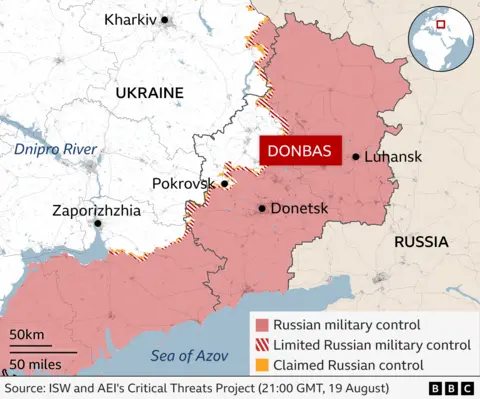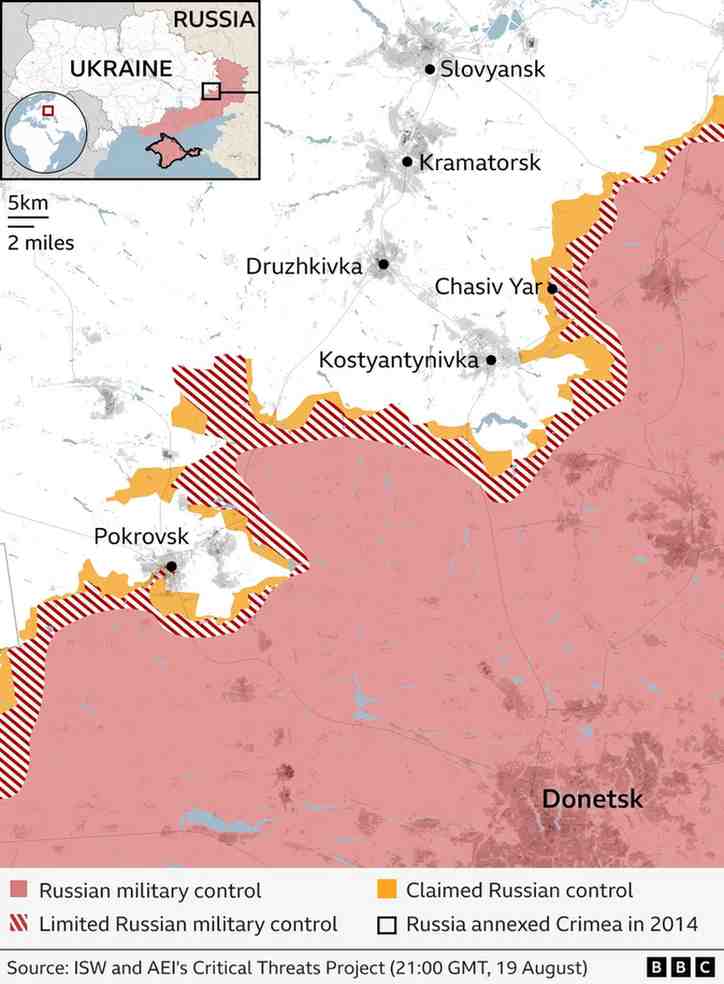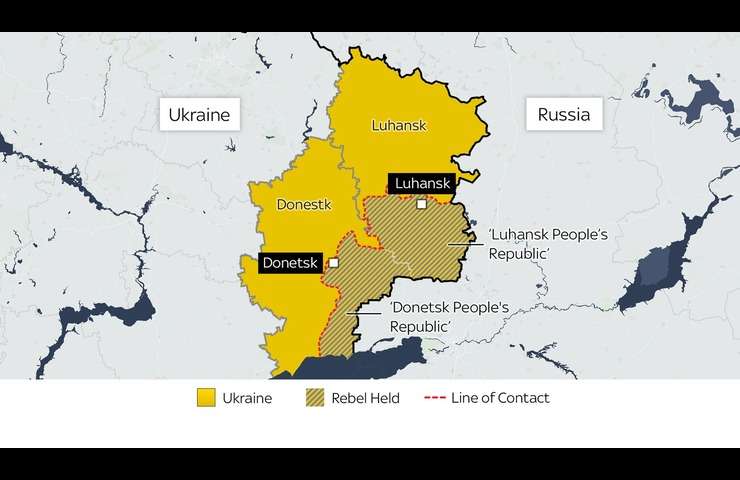When Russia launched its large-scale invasion of Ukraine in February 2022, the Donetsk region quickly became one of the most important fronts of the war. More than three years after the start of the war, Donetsk still plays a central role in Ukraine’s defense strategy. Its geographic, economic, and symbolic importance explain why both Kyiv and Moscow are still expending enormous military resources in the region.
Geostrategic Significance of Donetsk
Donetsk, the one of two provinces in the Donbas region of eastern Ukraine (along with Luhansk), has been partially controlled by Russia and Russian-backed separatists since 2014. As of mid-2025, Russia controls about 58% of the Donetsk oblast, including the major urban areas of Donetsk city and Mariupol. As of mid-2025, Ukraine maintains strong positions in Kramatorsk, Sloviansk, Pokrovsk and the rest of the industrial belt.
The region possesses vast geostrategic importance for various reasons:
Land Corridor to Crimea: Control of Donetsk ensures that Russian authorities maintain continuity of a land route from Rostov-on-Don (Russia) to Crimea and, should parts of this oblast be lost, it would disrupt supply lines for Russian authorities to maintain their control of Crimea and weaken their hold over parts of the occupied south.
Buffer for Dnipro and central Ukraine: Should Ukraine lose additional ground in Donetsk, Russian troops would be poised more easily draw within range of Dnipro, a significant logistical hub serving as the main artery for moving goods between eastern Ukraine and western Ukraine. Military Congruence: Donetsk has served as a heavily fortified, entrenched space therefore, Russian authorities, together with their proxies, have established a network of layered defenses, minefields, and artillery. Ukraine would need to overcome fortified positions throughout Donetsk to retake occupied territories, which has rendered Donetsk one of the most militarized locations in Europe.
 Industrial and Economic Significance of Donetsk
Industrial and Economic Significance of Donetsk
Donetsk historically has been Ukraine’s industrial backbone. The Donbas region accounted for around 16% of Ukraine’s GDP before 2014, with coal mining and steel and heavy industry prominent in the area. The relatively few steel processing plants, the Donetsk Metallurgical Plant and the Yenakiieve Iron and Steel Works, and a multitude of coal mines, helped Ukraine become one of the world’s few steel exporters. While much of this capacity has been destroyed or otherwise occupied since 2014. the industrial base still gives Moscow economic leverage. Mariupol’s Azovstal steel plant symbolizes this industrial importance that fell in May 2022 after a lengthy and heroic defense by Ukrainian forces. Ukraine continues to depend on the parts of Donetsk it now holds. The industrial site at Kramatorsk along with surrounding factories continue to underpin both civilian economy and military logistics by re-manufacturing equipment and machinery parts and providing repair facilities for armored vehicles.
Humanitarian and Demographic Dimension of Donetsk
Donetsk is also one of the most populous regions in Ukraine. Prior to 2014, Donetsk oblast had 4.3 million residents, making it the most populous province in Ukraine. Today, due to war and the displacement of over 2 million, the population has dropped, but still has a considerable civilian population to protect, which is a high priority for Kyiv. The humanitarian stakes are huge, with cities like Sloviansk and Kramatorsk subjected to regular shelling, and Russia’s advance in Avdiivka (captured in February 2024), which displaced tens of thousands. Ukraine’s defense of Donetsk is not only a military one, but a commitment to prevent its citizens from being displaced or occupied.
Symbolic and Political Stakes
Donetsk represents significant symbolic value. When Russian-backed separatists declared its self-styled “Donetsk People’s Republic” in 2014, it became a key element of the Kremlin’s propaganda machine. Losing Donetsk would seriously undermine Moscow’s claim of “protecting Russian-speaking populations.”
For Ukraine, Donetsk is about maintaining the integrity of the state. Losing any more Donetsk would have both territorial and psychological ramifications. Holding the line in Donetsk also sends reassurance to not just Ukrainians, but the world that Kyiv remains committed to recovering all occupied territory.

Military Realities on the Ground
War crimes in Donetsk are the gruesome among the bloodiest battles in the war. Western intelligence estimates suggest that over 50% of Russian casualties since February 2022 are in the Donetsk and Luhansk regions. Battles for cities (e.g., Bakhmut, which Wagner captured in May 2023 after months of attritional fighting) illustrate the tremendous costs associated with fighting for ground for both sides.
Ukraine has already poured many resources fortifying around Sloviansk and Kramatorsk, where it eagerly anticipates the next major assault by Russia if they persist in their westward push. In recent weeks, drone duels and artillery duels have ignited Russia to take the advantage of numerical superiority (an estimated 450,000 troops along the eastern front by mid-2025), which Favours Russia as it tries to grind down Ukraine (and their forces). Ukraine continues to survive with the support from Western military aid, particularly precision systems (e.g., HIMARS, Storm Shadow missiles; Patriot batteries), which mitigate to a degree Russia’s next advance upon Ukrainian defensive positions and allow Ukraine to strike at supply lines deep inside occupied Donetsk.
The International Environment
Donetsk’s fate will be viewed with keen interest across western capitals. U.S. and European officials argue that Ukraine’s ability to hold territory here will impact the negotiations around any potential future ceasefire or settlement. Establishing a strong Ukrainian defense to the city of Donetsk would give Ukraine a stronger negotiating position. Additionally, Donetsk encapsulates characteristics of what war is becoming: trench warfare, swarming drones, and exchanges of long-range missiles. NATO militaries no longer just watch the conflict unfold but are actively viewing Donetsk as a laboratory to explore tactics of contemporary war.
Conclusion
Donetsk is more than just land. It is the pivot point by which Ukraine’s defense, economy, and sovereignty turn. If Ukraine loses more of Donetsk, it will disrupt one of the only two defensive depths Ukraine has left; moreover, it will destroy Ukraine’s industrial capacity and give Moscow a strategic, wartime, victory. On the contrary, if Ukraine retains or recaptures territory in Donetsk, it provides depth to Ukraine’s defense while also providing some resilience to civilians and retains the full territorial vision of restoring Ukraine. As this war grinds into its fourth year, Donetsk remains much more than just a battlefield. It is the embodiment of Ukraine’s desire to defeat Russia’s war of aggression. For Kyiv, to defend Donetsk is to defend Ukraine itself.

